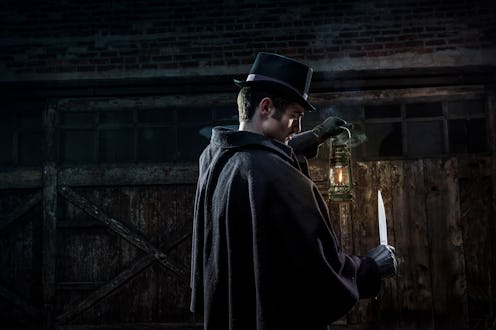Entertainment
The 'American Ripper's "Murder Castle" Isn't Accepting Guests Anymore

Looks like the true crime trend still has some life left in it, because History's latest docuseries American Ripper will examine the theory that notorious Chicago-based serial killer H.H. Holmes was "Jack The Ripper." The series will cover how Holmes committed his nightmarish murders in a "hotel" he designed and had built for himself in Chicago, at the same time that the city was preparing for the 1893 World's Fair. Though it's seen many horrific events happen within its walls, true crime fans might be interested in visiting if Holmes' hotel still exists today.
Like the man who built it, the hotel — nicknamed Holmes' "murder castle" — has a mysterious and complicated history. One of the reasons that the hotel is a point of fixation for Holmes obsessives is that so little concrete information is actually known about the murderer, including the number of his victims. Holmes confessed to 27 killings in a letter to New York City newspaper The Journal in 1896, but it's possible that this number is not accurate. According to an 1943 account of Holmes' spree in Harper Magazine, "estimates range[d] from 20 to a couple of hundred" and "newspapers of the day hinted that the correct total would be nearer 200, pointing out that great numbers of persons who visited the Fair in 1893 disappeared." (According to Biography.com, Holmes was convicted and hanged for the murder of his former partner in fraud, Benjamin Pitezel.)
The hotel could have been the setting for many — if not most — of these deaths. "Holmes ostensibly built the place as a hotel to accommodate visitors to the great Fair of 1893," the same Harper piece states. "It was months a-building; sometimes the work progressed with frantic haste; sometimes it languished." By the time it was complete, the hotel was what you might imagine an elaborate haunted house to be. "'There were staircases that led nowhere in particular,' blind passageways, hinged walls, false partitions, rooms with no doors, and rooms with many doors." The building accommodated Holmes' appetites in a way a traditionally built hotel would not have.
Unfortunately, you cannot make a pilgrimage to Holmes' hotel. In 2015, Chicagoist described the building's fate, saying that an A.M. Clark bought the hotel just a few weeks after the murder investigation and was set on turning it into a tourist attraction. But a subsequent explosion and fire destroyed all but the first floor of the building, which became a sign shop and bookstore. On the site now is a US Post Office, which has been there since the remaining original structure was razed and the property sold in 1938.
Ironically, according to the same Harper's article, Holmes had unsuccessfully attempted to set fire to the hotel in hopes of cashing in an insurance policy in late 1893, just a few years before his ultimate downfall. The Serial Killer Files theorizes that the fire that destroyed the castle may have been started by locals who did not appreciate Clark's attempt to make money on the backs Holmes' victims. Now, there's no tourist attraction to visit, and the fire may have eliminated any possibility of using modern forensic science on the site of the "murder castle," which might have helped determine a more accurate body count. Because of the murderer's deceptive nature, according to Rolling Stone, Holmes' body was exhumed in May 2017 to confirm its identity.
Unless you were aware of the Holmes story, you wouldn't feel anything amiss when you arrived on the site of many of his crimes. According to Atlas Obscura, the Englewood Post Office "is unremarkable in any way," and only a fraction of the size of Holmes' original property — "most of the 'castle' would have been in the space now occupied by the grassy knoll just east of the post office." Some adventurous folks head to the location to look for any trace of the place's history, but they need a lot of night vision to make this decidedly un-spooky place look out-of-the-ordinary.
Though you can't take a walk around its maze-like floorplan, the memory of H.H. Holmes' "murder castle" still persists on that Chicago site.